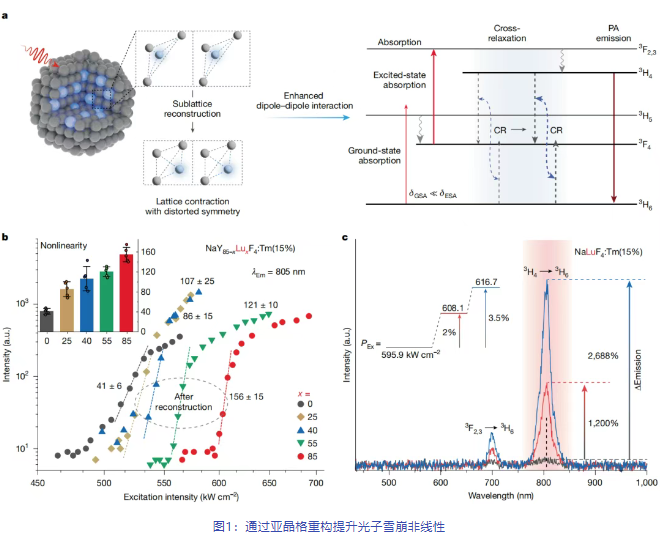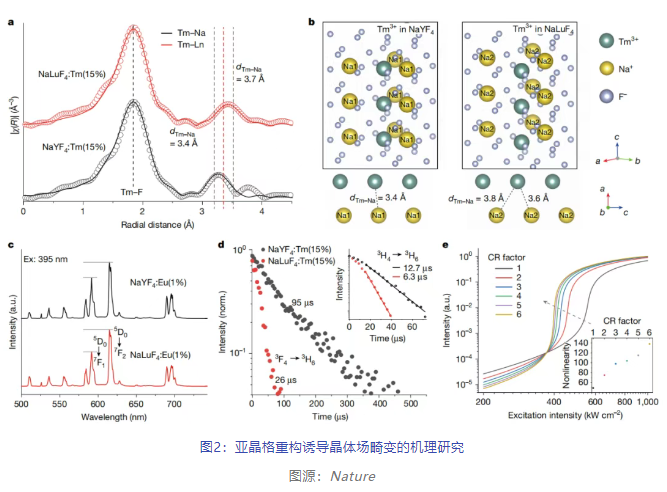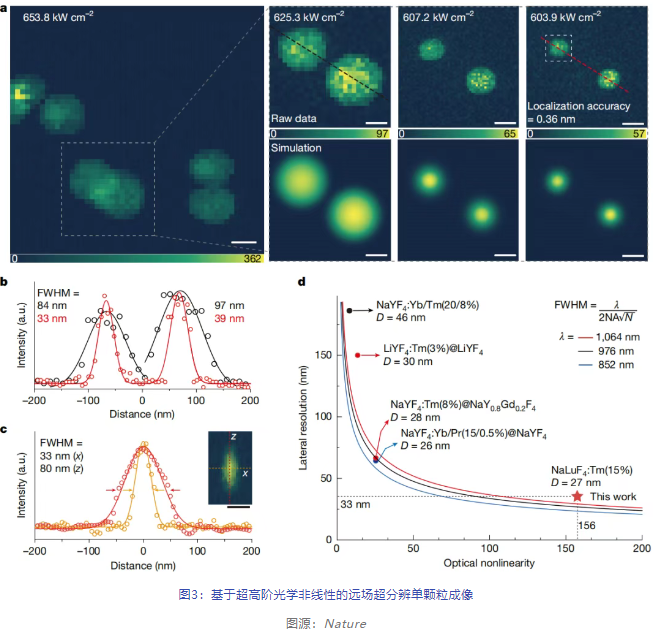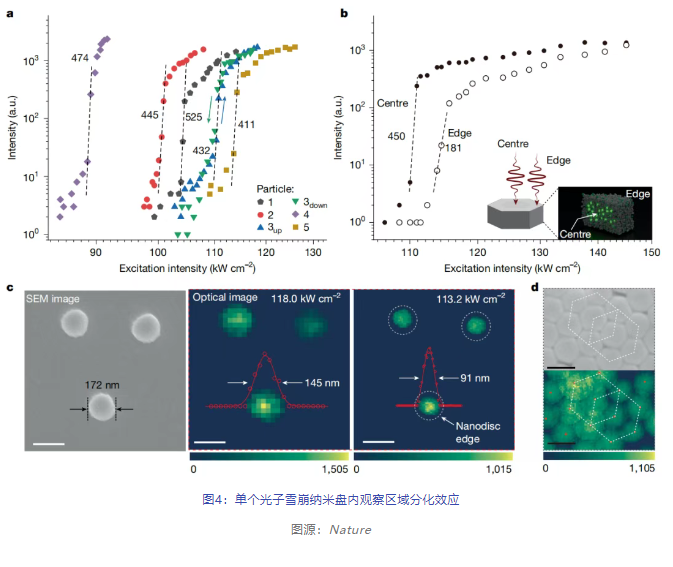06
2025
-
06
Photonic avalanche nanocrystals with >500-order optical nonlinear response
Author:
At the forefront of research into nonlinear optical materials, Upconversion photon avalanche (Photon Avalanche, PA) is a unique luminescence mechanism occurring in lanthanide-ion-doped systems. Under continuous laser pumping, it achieves an exponential response through an energy positive feedback loop mechanism, exhibiting ultra-high-order nonlinear optical behavior far exceeding traditional upconversion processes. This characteristic allows photon avalanche materials to induce significant changes in luminescence intensity even under weak excitation or environmental disturbances, thus showing unique application potential in low-cost super-resolution imaging, ultra-sensitive optical sensing, and multi-physical field detection.
The realization of photon avalanches is co-regulated by multiple luminescence dynamic processes, covering key factors such as the absorption capacity of avalanche ions, cross-relaxation efficiency, and excited-state energy dissipation dynamics. Among them, cross-relaxation between luminescent ions plays a core role in maintaining the accumulation of excited-state particles and the positive feedback loop. The 4f-4f transition of lanthanide ions has a low probability due to parity forbiddenness, but in low-symmetry crystal fields, this forbiddenness can be partially broken, thereby enhancing the electric dipole transition probability. Therefore, crystal field regulation, as an important means of regulating the local symmetry and energy level coupling strength of rare-earth ions, has significant potential in constructing high-nonlinearity index and fast-response photon avalanche systems.
Design ideas and working principles
The team first built an integrated optical platform integrating precise laser power control, three-dimensional piezoelectric displacement stage precise positioning, and gated single-photon counting detection, realizing intelligent acquisition and efficient analysis of photon avalanche fluorescence. Subsequently, the team, by using Lu 3+ ions with smaller ionic radius and larger atomic mass to replace Y 3+ ions, effectively regulated the arrangement tendency of vacancies and ions in the crystal, producing significant local crystal field distortion, and effectively accelerating the key cross-relaxation process in the photon avalanche process. Statistical analysis shows that this strategy successfully increased the optical nonlinearity of 27 nm nanoparticles from 40 to 156, significantly shortening the avalanche response time to 8.5 milliseconds, nearly 70 times shorter than traditional core-shell nanocrystals, exhibiting excellent fast response characteristics.


Far-field super-resolution microscopy
With the help of ultra-high-order optical nonlinearity, the research team achieved a spatial resolution of 33 nm (approximately 1/33 of the wavelength) laterally and 80 nm (approximately 1/13 of the wavelength) axially in a single-beam continuous-wave laser system, with a signal-to-noise ratio greater than 20 and a positioning accuracy of up to 0.36 nm, significantly better than currently reported photon avalanche materials, demonstrating great application potential in low-cost super-resolution imaging.

Regional response heterogeneity
By expanding the photon avalanche positive feedback network, the research team achieved an optical nonlinear response exceeding 500 orders in a 176 nm diameter NaLuF 4 :Tm nanoplates, setting a new record for the performance of photon avalanche nonlinear materials. More importantly, in the laser point-scanning imaging experiment, the team discovered for the first time that photon avalanche luminescence exhibits significant regional response heterogeneity: compared to the center, the nonlinear order of the edge region is significantly reduced, and the excitation threshold is increased. Based on this, the nanosample exhibits the phenomenon of "imaging size smaller than physical size," providing a new path to break through the imaging resolution limit traditionally limited by the physical size of the probe.

Summary and outlook
This study achieved a significant improvement in the cross-relaxation rate of the photon avalanche process through precise regulation of the local crystal field environment inside rare-earth-doped nanocrystals. This regulation strategy effectively enhanced the energy positive feedback process, greatly reducing the avalanche initiation response time, and thus achieving an ultra-high optical nonlinear response exceeding 500 orders. This breakthrough not only improves the performance of far-field single-beam super-resolution imaging but also builds a solid material foundation for multiple cutting-edge fields such as laser photonics, ultra-sensitive optical sensing and detection, chip-level optical signal regulation, nanomanufacturing, and quantum optics. Looking to the future, achieving miniaturization of avalanche nanomaterials and uniformity of single-particle nonlinearity is the key factor in realizing their in-depth application in imaging, sensing, and optical information fields. At the same time, achieving efficient coupling of these materials with advanced optical technologies will also be an important direction to further unleash their potential and accelerate the technological landing of nonlinear photon avalanche materials.
LATEST NEWS
2025-07-12
Hyperspectral channel density on-chip diffractive speckle spectrometer
Driven by the demand for high-performance miniature spectrometers, research on chip-scale spectrometers is continuously breaking through towards high integration, high resolution, and large bandwidth. This work proposes a silicon-based on-chip spectrometer based on cascaded disordered metasurfaces. Through various on-chip wavefront modulation mechanisms, high-spectral speckle is generated, which expands the number of spectral channels with a compact chip size, thus achieving extremely high on-chip spectral channel density and providing an effective means for achieving high-resolution, large-bandwidth spectral detection.
2025-07-14
Ultrasensitive room-temperature extreme photoelectric response achieved
This study, for the first time, achieved the control of ultra-sensitive photoelectric response optimized for room temperature conditions through electromagnetically induced potential well effects and exciton insulator phase transition characteristics.
2025-07-15
Preparation and research progress of glass scintillators for X-ray imaging
Developing suitable host materials with strong X-ray absorption coefficient, good exciton transport efficiency, low phonon energy, and high lanthanide ion solubility remains a cutting-edge research direction in the field of X-ray detection.
2025-07-16
Quantum logic gates based on single-piece gradient metasurface
In today's rapidly developing quantum information technology, realizing efficient and highly integrated quantum logic gates is one of the key challenges in the field of integrated quantum optics.
2025-07-17
Preparation and performance study of epoxy-thiol high-contrast color polymer dispersed liquid crystals
Polymer Dispersed Liquid Crystal (PDLC) is a smart material consisting of micron-sized liquid crystal droplets dispersed in a polymer matrix.

